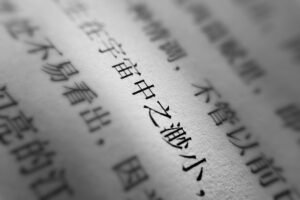Learning Chinese can be a fascinating and rewarding adventure for children. Understanding how to build simple sentences is the first step in mastering the language. This guide aims to break down the process, making it accessible and enjoyable for young learners. We’ll explore sentence structures, provide essential vocabulary, and include fun dialogues and activities to reinforce learning.
Table of Contents
ToggleUnderstanding the Basics: Subject-Verb-Object
In Chinese, the most common sentence structure follows the Subject-Verb-Object (SVO) order, similar to English. Here’s a quick breakdown:
- Subject (主语 – zhǔyǔ): The person or thing performing the action.
- Verb (动词 – dòngcí): The action being performed.
- Object (宾语 – bīnyǔ): The person or thing receiving the action.
For example, in the sentence “我吃苹果” (Wǒ chī píngguǒ – I eat an apple), “我” (Wǒ) is the subject, “吃” (chī) is the verb, and “苹果” (píngguǒ) is the object.
Step-by-Step Sentence Construction
1. Start with the Subject
The subject of a sentence in Chinese is often a pronoun or a noun. For children, using simple pronouns like “I” (我 – wǒ), “you” (你 – nǐ), and “he/she” (他/她 – tā) is a great start.
- 我 (wǒ) – I
- 你 (nǐ) – You
- 他/她 (tā) – He/She
- 我们 (wǒmen) – We
- 他们 (tāmen) – They
2. Add a Verb
Verbs in Chinese are relatively straightforward as they do not change forms like in English. Here are some basic verbs for children to learn:
- 吃 (chī) – eat
- 看 (kàn) – see/look
- 喜欢 (xǐhuān) – like
- 喝 (hē) – drink
- 玩 (wán) – play
- 走 (zǒu) – walk
- 学习 (xuéxí) – study/learn
- 跳 (tiào) – jump
- 跑 (pǎo) – run
- 听 (tīng) – listen
- 写 (xiě) – write
- 读 (dú) – read
- 说 (shuō) – speak
3. Finish with the Object
Objects can be nouns or pronouns. Here are some simple objects children might use:
- 苹果 (píngguǒ) – apple
- 书 (shū) – book
- 狗 (gǒu) – dog
- 水 (shuǐ) – water
- 球 (qiú) – ball
- 路 (lù) – road
- 学校 (xuéxiào) – school
- 音乐 (yīnyuè) – music
- 信 (xìn) – letter
- 故事 (gùshì) – story
- 食物 (shíwù) – food
- 朋友 (péngyǒu) – friend
Putting It All Together
Let’s combine these elements to form simple sentences.
- I eat an apple.
- 我吃苹果。(Wǒ chī píngguǒ.)
- You like books.
- 你喜欢书。(Nǐ xǐhuān shū.)
- He sees a dog.
- 他看狗。(Tā kàn gǒu.)
- We drink water.
- 我们喝水。(Wǒmen hē shuǐ.)
- They play ball.
- 他们玩球。(Tāmen wán qiú.)
- I listen to music.
- 我听音乐。(Wǒ tīng yīnyuè.)
- You write a letter.
- 你写信。(Nǐ xiě xìn.)
- He reads a story.
- 他读故事。(Tā dú gùshì.)
Vocabulary Expansion
As children become comfortable with basic sentence structures, introduce more vocabulary. Here are additional words to help expand their sentences:
Verbs (动词 – dòngcí)
- 听 (tīng) – listen
- 写 (xiě) – write
- 读 (dú) – read
- 跳 (tiào) – jump
- 跑 (pǎo) – run
- 买 (mǎi) – buy
- 做 (zuò) – do
- 学 (xué) – learn
- 玩 (wán) – play
- 吃 (chī) – eat
- 喝 (hē) – drink
- 看 (kàn) – look/watch
- 说 (shuō) – speak
Nouns (名词 – míngcí)
- 苹果 (píngguǒ) – apple
- 书 (shū) – book
- 狗 (gǒu) – dog
- 水 (shuǐ) – water
- 球 (qiú) – ball
- 路 (lù) – road
- 学校 (xuéxiào) – school
- 音乐 (yīnyuè) – music
- 信 (xìn) – letter
- 故事 (gùshì) – story
- 食物 (shíwù) – food
- 朋友 (péngyǒu) – friend
- 车 (chē) – car
- 家 (jiā) – home
- 老师 (lǎoshī) – teacher
- 同学 (tóngxué) – classmate
- 爸爸 (bàba) – dad
- 妈妈 (māma) – mom
Word List
Pronouns
- 我 (wǒ) – I
- 你 (nǐ) – You
- 他/她 (tā) – He/She
- 我们 (wǒmen) – We
- 他们 (tāmen) – They
Verbs
- 吃 (chī) – eat
- 喝 (hē) – drink
- 玩 (wán) – play
- 走 (zǒu) – walk
- 看 (kàn) – see/look
- 喜欢 (xǐhuān) – like
- 学习 (xuéxí) – study/learn
- 听 (tīng) – listen
- 写 (xiě) – write
- 读 (dú) – read
- 跳 (tiào) – jump
- 跑 (pǎo) – run
- 说 (shuō) – speak
- 买 (mǎi) – buy
- 做 (zuò) – do
- 学 (xué) – learn
Nouns
- 苹果 (píngguǒ) – apple
- 书 (shū) – book
- 狗 (gǒu) – dog
- 水 (shuǐ) – water
- 球 (qiú) – ball
- 路 (lù) – road
- 学校 (xuéxiào) – school
- 音乐 (yīnyuè) – music
- 信 (xìn) – letter
- 故事 (gùshì) – story
- 食物 (shíwù) – food
- 朋友 (péngyǒu) – friend
- 车 (chē) – car
- 家 (jiā) – home
- 老师 (lǎoshī) – teacher
- 同学 (tóngxué) – classmate
- 爸爸 (bàba) – dad
- 妈妈 (māma) – mom
Forming Questions
Forming questions in Chinese is also quite simple. Typically, you can add the question particle 吗 (ma) at the end of a statement.
- Do you like apples?
- 你喜欢苹果吗?(Nǐ xǐhuān píngguǒ ma?)
- Is he reading a book?
- 他在读书吗?(Tā zài dú shū ma?)
Simple Dialogues
Creating dialogues can help children practice speaking and understanding the flow of conversation. Here are a few examples:
Dialogue 1: At the Park
小明 (Xiǎomíng): 你在做什么?(Nǐ zài zuò shénme?) 小红 (Xiǎohóng): 我在玩球。(Wǒ zài wán qiú.) 小明 (Xiǎomíng): 我也喜欢玩球。(Wǒ yě xǐhuān wán qiú.)
Translation: Xiaoming: What are you doing? Xiaohong: I am playing with a ball. Xiaoming: I also like playing with a ball.
Dialogue 2: At School
老师 (Lǎoshī): 你们喜欢学习中文吗?(Nǐmen xǐhuān xuéxí zhōngwén ma?) 学生们 (Xuéshēngmen): 我们喜欢学习中文!(Wǒmen xǐhuān xuéxí zhōngwén!)
Translation: Teacher: Do you like learning Chinese? Students: We like learning Chinese!
Dialogue 3: At Home
妈妈 (Māmā): 你饿吗?(Nǐ è ma?) 孩子 (Háizi): 我饿了。(Wǒ è le.) 妈妈 (Māmā): 我们吃饭吧。(Wǒmen chīfàn ba.)
Translation: Mom: Are you hungry? Child: I am hungry. Mom: Let’s eat.
Dialogue 4: Visiting a Friend
朋友 (Péngyǒu): 你想玩什么?(Nǐ xiǎng wán shénme?) 你 (Nǐ): 我想玩球。(Wǒ xiǎng wán qiú.) 朋友 (Péngyǒu): 好啊!(Hǎo a!)
Translation: Friend: What do you want to play? You: I want to play with a ball. Friend: Okay!
Fun Activities
1. Flashcards
Create flashcards with subjects, verbs, and objects. Have children pick one card from each category and form sentences. This helps reinforce vocabulary and sentence structure.
2. Sentence Matching
Write down subjects, verbs, and objects on separate cards. Mix them up and ask children to match them correctly to form sentences. This can be a fun group activity.
3. Story Time
Ask children to make up short stories using the simple sentences they’ve learned. This encourages creativity and helps them understand how sentences flow together to form a narrative.
Review and Practice
Regular review and practice are essential for mastering any language. Encourage children to:
- Repeat sentences aloud: This helps with pronunciation and memorization.
- Write sentences: Writing reinforces grammar and vocabulary.
- Engage in conversations: Practicing with peers or family members can boost confidence.
Real-Life Contexts
To help children see the practical use of what they’re learning, introduce sentences and dialogues that they might use in everyday life. For example:
At the Market
你 (Nǐ): 我想买苹果。(Wǒ xiǎng mǎi píngguǒ.) 商店老板 (Shāngdiàn lǎobǎn): 好的,这个苹果很好吃。(Hǎo de, zhège píngguǒ hěn hǎo chī.)
Translation: You: I want to buy apples. Shopkeeper: Okay, these apples are very tasty.
In the Classroom
老师 (Lǎoshī): 请你读这本书。(Qǐng nǐ dú zhè běn shū.) 学生 (Xuéshēng): 好的,老师。(Hǎo de, lǎoshī.)
Translation: Teacher: Please read this book. Student: Okay, teacher.
At Home
爸爸 (Bàba): 你做完作业了吗?(Nǐ zuò wán zuòyè le ma?) 孩子 (Háizi): 我做完了。(Wǒ zuò wán le.)
Translation: Dad: Have you finished your homework? Child: I have finished.
Conclusion
Building simple sentences in Chinese is a foundational skill that paves the way for more complex language structures. By breaking down the process into manageable steps and engaging in regular practice, children can quickly gain confidence in their Chinese language abilities. Through fun and interactive methods, learning Chinese can become an enjoyable and enriching experience. Happy learning! (学得开心 – xué dé kāixīn!)







